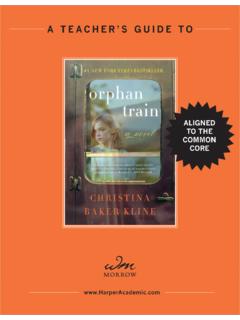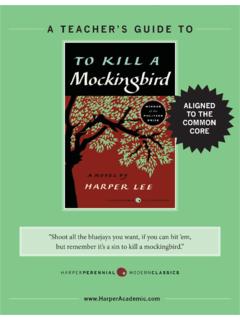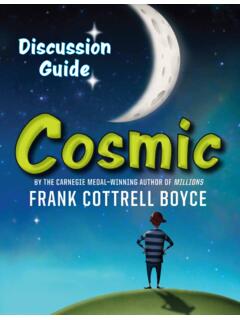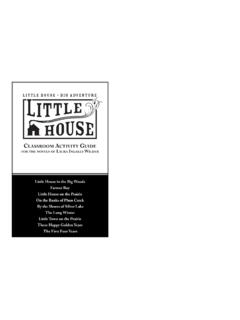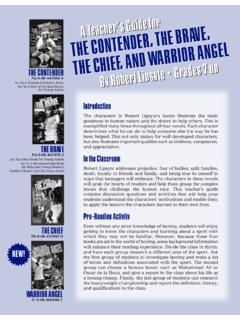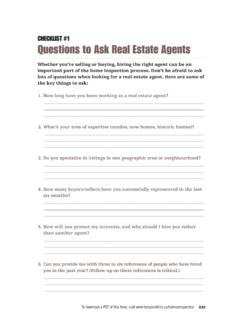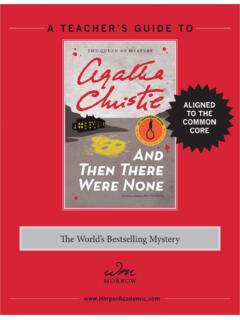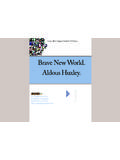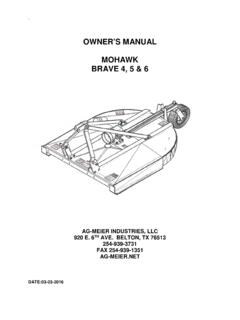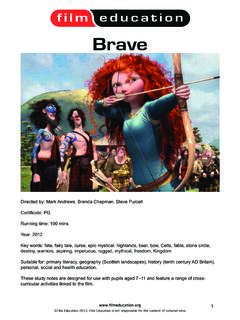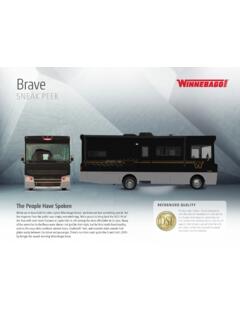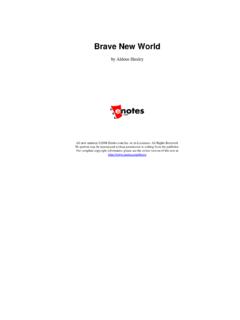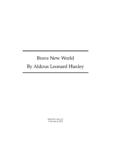Transcription of A TEACHER’S GUIDE TO - HarperCollins
1 Aldous Huxley is the greatest 20th-century writer in English. Chicago TribuneA TEACHER S GUIDE TOALIGNED TO THE COMMON A TEACHER S GUIDE TO ALDOUS HUXLEY S brave NEW world 2 Table of ContentsNote to Teachers 3 About This GUIDE 3 Guided Reading Questions 4 Chapter One 4 Chapter Two 4 Chapter Three 5 Chapter Four 6 Chapter Five 6 Chapter Six 7 Chapter Seven 7 Chapter Eight 7 Chapter Nine 8 Chapter Ten 8 Chapter Eleven 9 Chapter Twelve 9 Chapter Thirteen 10 Chapter Fourteen 10 Chapter Fifteen 10 Chapter Sixteen 11 Chapter Seventeen 11 Chapter Eighteen 11 Writing and Discussion Prompts 12 Topics for Argumentation Essays or Debate 12 Topics for Informative Writing 13 Topics for Narrative Writing 13 Research Topics 14 Works by Aldous Huxley 15 Other Dystopian Titles of Interest 16 About This GUIDE s Author 16 A TEACHER S GUIDE TO ALDOUS HUXLEY S brave NEW world 3 NOTE TO
2 TEACHERSIn the past several years there has been an explosion of interest in dystopian fiction among young adults. Popular series like Hunger Games, Uglies, and Divergent have renewed student interest in this genre, and teachers are encouraged to use this interest to intro-duce a unit on dystopian fiction/the individual vs. society that features brave New world as an anchor text. John, the Savage of brave New world , references several works by William Shakespeare. Students will likely be familiar with Romeo and Juliet, but teachers may also find it helpful to build background knowledge by exposing their students to the play Othello prior to teaching brave New world . The questions and activities in this teaching GUIDE were written to support standards-based instruction. brave New world meets the standard for Range of Reading and Level of Text Complexity for grades 9-10.
3 A complete list of the Common Core State Standards can be found at ABOUT THIS GUIDEThis Teacher s GUIDE is divided into three sections. The first, Guided Reading Questions, will help students with reading com-prehension and appreciation. These questions can be used as a GUIDE for annotating the text, journal responses, or discussion. A focus on analysis of both characters and the structure of the novel is embedded within the questions. Lists of vocabulary words for each chapter are provided in order to facilitate the teaching of vocabulary in context. The second section, Writing and Discussion Prompts, consists of analytical writing and discussion prompts and is subdivided into genres based on the Common Core writing standards. Consulting established literary criticism may be beneficial for advanced students, but it is not necessary.
4 The topics in the third section, Research Topics, will require students to conduct and synthesize significant outside research on topics related to the novel. A TEACHER S GUIDE TO ALDOUS HUXLEY S brave NEW world Write routinely over extended time frames (time for research, reflection, and revision) and shorter time frames (a single sitting or a day or two) for a range of tasks, purposes, and ONEVo c a b u l a r y : pallid, callow, abject, geniality, florid, zealous, salinity, viscosity, bouillon, prodigious, viviparous, vivacious, intermi-nable, deft, optimum, predestination, sultry, caste, decant 1. Explain how Huxley uses imagery to establish setting and mood. Cite specific examples that you find particularly effective in your response. The world State s motto suggests that community, identity, and stability are the most important qualities in their society.
5 What do you believe are the three most important values for a society? Explain your answer. Explain the fertilization process used in brave New world . How does the Hatching and Conditioning Centre acquire the necessary ovum and spermatozoa? What is Bokanovsky s Process? Which classes undergo Bokanovsky s Process? Which do not? Why would Bokanovsky s Process help create social stability? Based on context clues, what do you think the term unforeseen wastages is a euphemism for (10)? What do you think a freemartin is (13)? According to Mr. Foster, at what point does the Centre leave the realm of imitating nature and begin to apply human invention to reproduction? What is the purpose of depriving some embryos of adequate oxygen? Why do the scientists hope to discover a way to speed up maturation? According to the Director, what is the secret of happiness and virtue?
6 Do you agree with him? Explain your answer. Explain some of the processes that the Centre uses to prepare embryos for their inescapable social destiny (16-17). TWOVo c a b u l a r y : viscose, posthumous, apoplectic, suffuse, indissolubly, gratuitous, smut, sibilant, imperative, indefatigably, inculcate, insinuating Research the experiments of Ivan Pavlov and explain Pavlov s theory. Explain the conditioning exercise that the Delta infants at the Centre experience. What is the purpose of the lesson ? How does it reflect the Pavlov s theory? Explain the economic rationale for conditioning lower-caste children to hate flow-ers. What is suggested by Huxley s decision to replace the words mother and father with crash and crash and wink and snigger (25)? How was hypnop dia discovered? What were its limitations?
7 Based on context clues, what historical figure is referred to as Our Ford ? Reading Questions A TEACHER S GUIDE TO ALDOUS HUXLEY S brave NEW world 56. What is moral education? Why was it possible to adapt hypnop dia for moral education? Explain the methods used by the class, Elementary Class Consciousness, to condition children. What does Huxley mean when he compares hypnop dia to drops of sealing wax falling on granite (28)? How do you think the Director would have finished the sentence It therefore (29)? Explain how Huxley develops the motif of Henry Ford as a God figure. Use specific examples from the text to support your analysis. THREEVo c a b u l a r y : centrifugal, rudimentary, patronizing, contempt, maudlin, rigorously, suppressed, incredulity, surreptitious, averted, unsavory, bunk, derision, contemptuous, teeming, rabble, evocation, squalid, chypre, inscrutable, sadism, chastity, incongruous, emphatically, axiomatic, truculently, stickler, furtive, keen, pneumatic, insurmountable, degrading, indignant Explain how Centrifugal Bumble-puppy is played.
8 What is the government s perspective on the purpose of games? How does the Director respond to the children he catches engaged in sexual play? In this society, what sort of behavior is considered normal and abnormal? What does the Director tell the students about the way children were raised in the past? How do the students respond to this information? Who is Mustapha Mond? Beginning on page 34, Huxley juxtaposes scenes between the Director and his students with scenes between Henry Foster and Bernard Marx and scenes of a discussion between Fanny and Lenina Crowne. What is happening in each of these three vignettes? What effect does the juxtaposition of the scenes create? Explain the saying History is bunk. Consider the list of things (found on page 35) that the Controller dismisses and sug-gest a reason for his inclusion of these particular examples of bunk.
9 Are there any common themes among them? Based on context clues, what are Feelies (35)? How does the Director describe what a home was? Why effect does his description have on the students? What treatment is Fanny undergoing? How do you think the treatment works? Why do you think it would be prescribed? According to the Director, why did Ford/Freud decide that families were dangerous? Explain the meaning of the proverb: every one belongs to every one else. What does Huxley suggest about the reason that the students accept this proverb as truth? Why does Fanny disapprove of Lenina s relationship with Henry Foster? Explain the allegory that the Director makes using water under pressure in a pipe. How does it illustrate the danger of monogamy or other exclusive relationships? According to the Director, why does promiscuity lead to stability?
10 What does it mean to call a woman pneumatic? Why does Henry Foster s conversation about Lenina anger Bernard Marx? A TEACHER S GUIDE TO ALDOUS HUXLEY S brave NEW world 615. Why doesn t Fanny approve of Lenina s interest in Bernard Marx? What is the rumor about Bernard? What is Ectogenesis? According to the Director, why did world governments initially reject this scientific advancement? What other technological and social advances/reforms did they reject, and for what reason? What changed their minds? Explain the conscription of consumption (49). How are citizens conditioned to become consumers? Why would appre-ciating culture or nature be at odds with consumption? Based on context clues, what do you think Simple Lifers were? What happened to them? What is a Malthusian belt? What is soma? What purpose does it serve in society?
